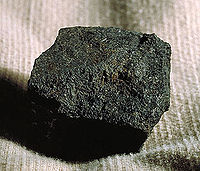
Photo from wikipedia
A growing demand exists on the monitoring of both uranium mining activities and their environmental impacts. In order to help understanding and modelling both these aspects, a thermodynamic database dedicated… Click to show full abstract
A growing demand exists on the monitoring of both uranium mining activities and their environmental impacts. In order to help understanding and modelling both these aspects, a thermodynamic database dedicated to uranium mining activities is developed: the PRODATA database. Relevant species and phases for uranium and radium are chosen from existing compilations of data, complemented with important missing data for the application to mining activities and environmental monitoring. Important major anions and cations chemistry are included, as well as secondary pollutants such as arsenic, lead, or nickel. Applications of the PRODATA extracted database file for PhreeqC to theoretical speciation calculations of uranium and radium for actual water compositions - either linked to uranium mining activities, or under monitoring for environmental survey - are presented. Wider applications to other available water compositions from different geochemical concepts are also tested. For the tested cases, the major radium and uranium species obtained using PRODATA are compared with other available thermodynamic database (Thermochimie, LLNL, Wateq4f, Minteq, PSI/NAGRA). The choice of the database file - and of the ionic strength correction - can strongly impact the final speciation results. Sulphate complexes of radium and uranium are of particular importance in mining exploitation context, and carbonate uranium complexes - particularly [Formula: see text] complexes - are crucial for environmental monitoring. The latter complexes are key species for the aqueous speciation of uranium, even in reducing environment where U(IV) low solubility usually governs uranium mobility.
Journal Title: Chemosphere
Year Published: 2020
Link to full text (if available)
Share on Social Media: Sign Up to like & get
recommendations!